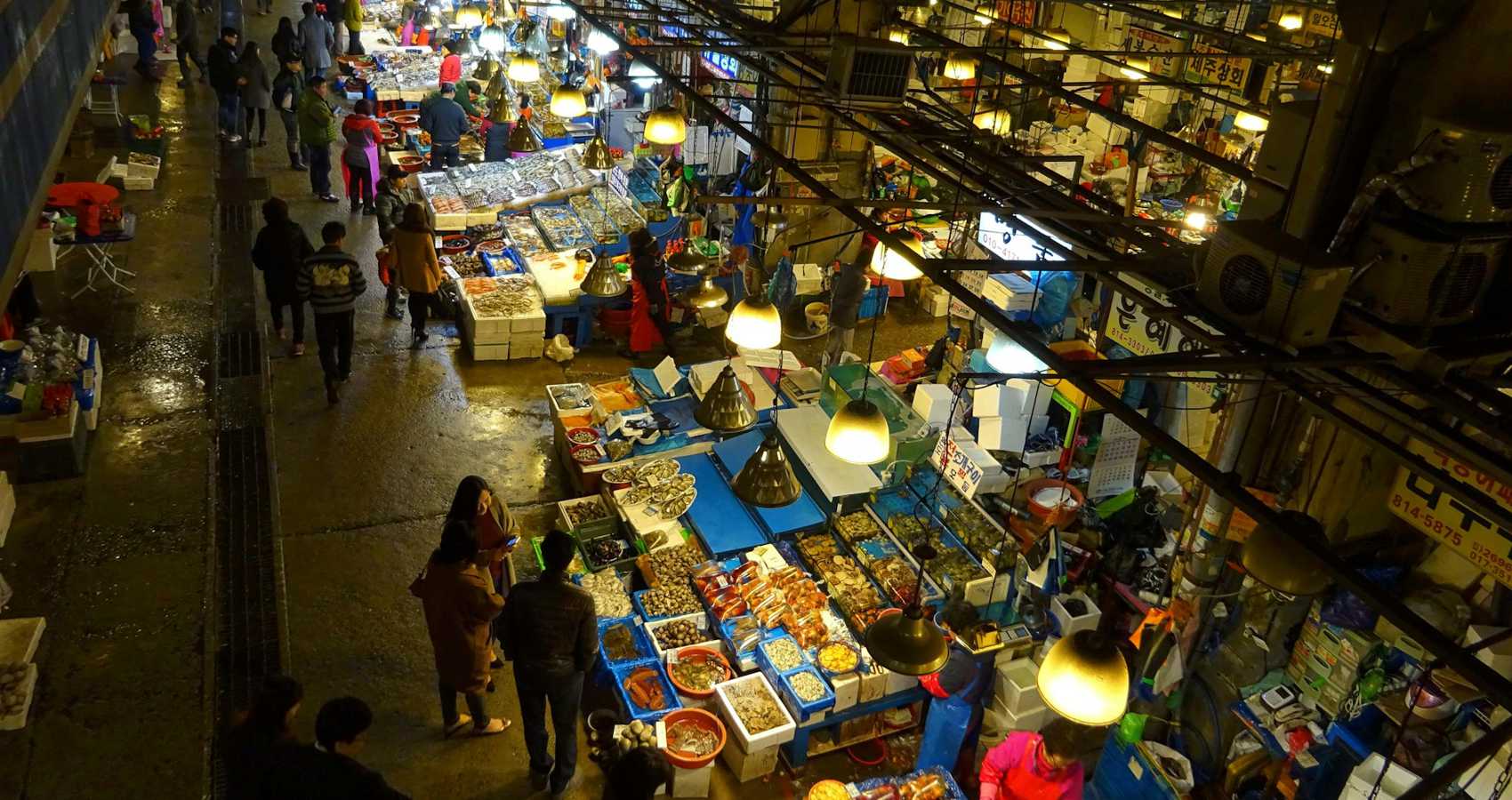Pain on a Korean Island
written by: Ken Weiss
“If you marry that American,” asked my future mother-in-law, “where will I find you? In the Con Chin China.” She used that term to mean the place on the globe farthest from where we were, in Bogota, Colombia. Love was strong; however. Her daughter and I were married and moved to New York.
Just six months later, in December 1967, Beatrice became an American citizen via expeditious naturalization. We left New York by plane, stopped for a few days each in California, Hawaii, the Philippines, and Taiwan, and landed in Seoul, Korea. I was to be part of a team, funded by the US Agency for International Development, to help improve marketing and increase exports. Korea is now a business powerhouse, but then it was just beginning to modernize.
As soon as the plane door opened in Seoul, we were hit by the smell of kimchi, the spicy, fermented cabbage that, traditionally, sustained Koreans through the winter. Families prepared it in the fall and stored it in large clay jugs, buried in the ground. A sewer system had been installed in much of Seoul, so there was no competition from the aroma of collecting and spiriting away, the contents of chamber pots.
Beatrice and I were assigned a house on the U.S. Army South Post, not far from Seoul’s South Gate. There were once four elaborate wooden fourteenth-century gates to the city. They were named Heunginjimun (East Gate), Donuimun (West Gate), Sungnyemun (South Gate), and Sukjeongmun (North Gate), and directions were always said in that order. We were allowed to use the US Overseas Mission (USOM) club and to shop in the Post Exchange (PX) and the commissary. We quickly acquired two essential items, a small Datsun car, made in Japan, and a Korean housekeeper.
Beatrice interviewed potential housekeepers. The first was an attractive young lady who had to admit that she had no experience—did not know how to cook or iron, for example. The first one we hired was a young man, did not stay long. He liked baking pies but did not like to do much else. He insisted on grinding ice cubes in the blender, but Beatrice did not like that, the two argued, and he left in a huff. Our second housekeeper, Elena, stayed with us for our two-year stint. Not long after we left Korea, she did also, and fulfilled her dream of going to the U.S. and becoming a nun.
There were parties for newcomers in the USOM Club, and the one we attended was delightful. Everyone was welcoming and interesting to talk with. A few days later, Beatrice was invited to a tea party for wives of non-military men who lived in South Post. She had previously met a lady named Mrs. Fuchs. Arriving at the tea party, she remembered the spelling but not the pronunciation. She greeted Mrs. Fuchs loudly but said her name badly, and it was a while before anyone dared to laugh.
Nonetheless, Bea made friends quickly. There was a plump Jewish lady who taught her how to prepare delightful meals and a Chinese/Cuban lady whose husband, we thought, worked for the CIA. We didn’t ask, of course. We knew he would answer “no.”
At one party, we met the director of the International Institute of Culture and Science, in Seoul. He talked with us in Spanish and then said he was looking for a Spanish teacher for the institute. A few days later, he offered Bea a part-time job, and she accepted. A black sedan from the institute came on weekday mornings and took her to downtown Seoul. She taught young men who were preparing to work in Spanish-speaking countries, some for private companies and others for the Korean government. At the end of the course, she invited them to our house for dinner so they could practice table talk in English as well as eating with knives and forks, instead of chopsticks.
In time, we inherited a small dog from a family that was leaving the country. We named it “Vaina,” a Latin American word for nearly anything. We made Vaina an indoor/outdoor dog; free to come and go. We had heard of the belief that eating dog meat in the fall would help one resist cold weather but did not know much about it. It was a practice that eliminated strays from the streets every year around August, and family pets that ran wild were also in danger. One day, our little dog disappeared and was never seen again. The government has tried to stop the practice of eating dog meat, but it is a long-held custom. Also, numerous small butcher shops and restaurants would be affected by a ban. There is now talk of making it illegal to consume this meat, as of the year 2027.
The Korean conflict, from June 1950 to July 1953, was a proxy war between the US and China, fought on the Korean Peninsula. As of now, it has not ended. There is only an armistice between North Korea and South Korea that went into effect in 1963 and can be broken at any time.
A few weeks after we arrived in the country, in January 1968, the North Korean military captured the USS Pueblo, a small American spy ship. The argument over whether it was in North Korean or international waters has never been settled. One crewman was killed, and the other eighty-two were taken captive. Immediately, US civilians in South Korea were instructed to participate in an evacuation drill. We had to report, at a given time and place, carrying only essential items, including clothes for winter and summer because our destination was unknown. Pets were not included on the permissible list, but our Chinese/Cuban friend would not leave hers behind. She reported as instructed but with her miniature poodle hidden in her bulky fur coat. We were lined up next to a plane as if to board it but never had to do so.
The political situation soon cooled enough for the two sides to begin negotiating, but this was complicated by “incidents,” including a thwarted attack by North Korean agents on the Blue House, home of the South Korean government, and therefore on the government as a whole. It took eleven months for North Korea to return the crew of the USS Pueblo, including the body of the deceased sailor. The ship has never been returned and is now a museum on a canal in Pyongyang.
We did not receive much news from the US, but one item stands out. In early April 1968, our team leader and I were walking toward each other, and he blurted out, “They killed King.” The assassination of the Reverand Martin Luther King was sobering. It made us all realize that no matter what progress was made toward peace, there would be setbacks.
One of the delights of life in Seoul was visiting a fabulous silk market, of which there were several in the city. There was one adjacent to South Gate and very convenient for us. There were rows and rows of silk fabric and garments in a rainbow of colors, and Beatrice still has silk dresses that she bought there. I have heard that the markets still exist but that most of the textiles in them now are synthetic.
My shopping was done more in the Shinsegae, a modern department store that had opened in 1960. It still exists and has expanded to other locations. I have a beautiful wool topcoat from that store and wear it once or twice a year. It is so heavy that I fear it will break the bar in my closet.
A custom we found interesting was that Korean babies were not given names until they were one hundred days old—old enough to conclude that they would probably survive. At that time, the baby would be celebrated and would be considered one year old. This makes sense—nine months in the womb and one hundred days outside of it. On the other end of the life cycle, women who reached the age of sixty were considered free of responsibilities. We often saw groups of them dancing in parks.
At that time, several dealers offered antique art and furniture, in small shops and on “home visits.” They would go to houses in the country, see items they liked, and trade for them. Their spiel was something like, “You don’t want that old chest, do you? Let me take it, and I’ll give you a nice new one.” One such dealer came to our house, and Bea and I bought chests and other pieces, which we have and use, fifty-five years later. They would be valuable except that they have been slightly damaged over the years.
Koreans loved walking in the low mountains, and my Korean assistant and interpreter invited us at least once to hike among small hills with other people. He was an energetic young man, perhaps because he drank Coca-Cola frequently and added sugar to it. After my project ended, he found work with a bank and then with the Hyundai corporation, where he moved up to an important position.
Beatrice and I, with our maid as a translator, traveled some within the country. In the winter of 1968-69, we took a small ferry from the west coast to visit a religious shrine—probably Buddhist—on an island near the 38th Parallel, the line between a booming South Korea and a militaristic North Korea. Traveling north in the Yellow Sea, the boat did not really dock. It just slowed down so passengers could jump off and jump on. At our destination, we were preparing to jump off when the boat pulled away from the pier. The next, and last, stop on the route was a tiny island quite close to that dangerous dividing line.
Very soon, local authorities found they had a hot potato on their hands. They were afraid that if North Koreans learned that Americans were there, they might create an international incident or, worse, try to kidnap us. Also, they wondered why one man was traveling with two women. Someone guided us to a tiny informal hotel, which offered a bed on the floor and provided a light supper. The next morning, police officers woke us up with bright flashlights at four a.m. and made sure we took the first boat south. The boiled eggs the hotel gave us were very welcome.
We soon reached the island we had missed on our way north. As I got off the small boat, I doubled over from pain and could barely walk. A kind resident showed me to the warmest spot in her house, on the “ondul” floor, which was made of clay and heated by large charcoal cylinders in a tunnel beneath it. If this kind of floor leaks, poisonous gases seep into the living quarters. The kind lady covered me and offered tea, which my Colombian wife insisted I not drink because she feared the water was not safe.
Beatrice, who had never seen a real winter and did not speak English well, set off running across the snow, with our maid to interpret. They were shown to the island’s only telephone, which had to be hand-cranked frequently. Despite language problems and much static, they contacted the US Embassy and were told that a US military helicopter would rescue me. We said goodbye to our hosts and reached a designated landing site just as the copter did. There was no room for our maid, so we gave her money for the boat and the bus. As the helicopter lifted off, we saw lines of people walking down from the hills to see what was happening
When we landed at a US military hospital north of Seoul, the pain was subsiding. I was diagnosed with a kidney stone and anesthetized. A doctor went in, or up if you prefer, to seize the offending object. I awakened to see Beatrice talking with a Spanish-speaking nurse. The nurse asked how I felt, and I blurted, “me duele la cosita” (my little thing hurts). A few weeks later, we returned to the island and gave the family that had helped us a Korean-made transistor radio—something that few families on the island possessed. The people were surprised to see us; they had been sure I would die.
My group was assigned to work out of a small building near the Blue House, the seat of a democratic government. We had little contact with anyone else in our building. The USAID program was still in its infancy, so there were not many other contract personnel to share ideas with. Fortunately, the four of us, and occasional short-term specialists, got along well.
Our work included many meetings, and my teammates and I began to understand some of what was said in the Korean language, Hangul. We would pick up on gestures, facial expressions, a few words in English, and a few words in Hangul that we had learned. One of us–not I–even corrected the interpreter a few times. We organized workshops and seminars, and I once had the task of interrupting and embarrassing a prestigious college professor because he was droning on and on. We helped plan and put on the first fish marketing seminar and had the displeasure of seeing canned fish that did not look even close to edible. We took our lives in our hands and tasted samples. Later, we spearheaded the organization of a “Distribution Research and Development Training Institute,” whose initials were DRDTI, and which we promptly baptized “Dirty.”
The incredible Korean can-do spirit drove the country to advance quickly. In our first months there, an outdoor trade show was set to open in Seoul. It had rained hard, and, on opening day, a small truck got stuck in the center of the fairground. There was no way to remove it in time, so, what did they do? They cleaned and polished it, put a low fence around it, and made it part of the exhibit.
More and more trucks were appearing in Seoul, but many goods moved in the city on less modern vehicles. Couriers would carry huge loads, piled on the backs of bicycles. I saw one fall over with its load of cases of bottled soft drinks. The poor rider must have lost hours of time and probably had to pay for the broken bottles. Small three-wheeled trucks also plied the streets. Similar vehicles are still produced and used in some Asian countries.
At that time, Korea was clearly a man’s country. People still married young, and a man’s first wife generally took care of the house and the children. Men who could afford second wives would have them, although they could not be legally married to more than one at a time. The second wife lived in a separate house. She was often well-educated and good-looking and accompanied her “husband” to social events.
As new arrivals, the four men in my working group, all married and three with wives in Korea, were invited to more than one kisaeng party. These were the equivalent of geisha parties in Japan. Each man was assigned a woman who looked after his needs for food and drink and was available to rub his back. As far as I knew, that was all they did. Those parties were delightful except for the pressure to drink too much of the local alcoholic beverage, “chung jung.” It was similar to Japanese saki.
Men were largely free to enjoy the company of prostitutes, especially when they traveled. A male could arrive at a hotel and ask the desk clerk to provide a female companion. When she arrived, she would go into the room but leave her slippers outside the door. They were a signal to anyone passing by that the room’s occupant was engaged. Also, there were reportedly massage parlors where the normal service could be supplemented by a “special massage.” This kind of massage parlor was a growing business in the US in about the year 2000 but, after a time, was outlawed in some states. Many of the employees, young, Asian women, were found to be victims of human trafficking.
After two fascinating years in South Korea, Beatrice and I returned to the US, with brief stopovers in Thailand, Cambodia, Pakistan, Iran, and countries in Western Europe. To this day, we enjoy speaking our few words of Hangul and using chopsticks in Korean restaurants, and we have a bottle of kimchi in our refrigerator.
- Adventures in Bolivia - March 7, 2025
- Pain on a Korean Island - August 7, 2024



